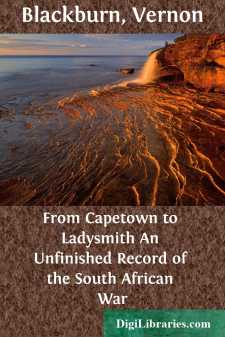Categories
- Antiques & Collectibles 13
- Architecture 36
- Art 48
- Bibles 22
- Biography & Autobiography 813
- Body, Mind & Spirit 142
- Business & Economics 28
- Children's Books 17
- Children's Fiction 14
- Computers 4
- Cooking 94
- Crafts & Hobbies 4
- Drama 346
- Education 46
- Family & Relationships 57
- Fiction 11829
- Games 19
- Gardening 17
- Health & Fitness 34
- History 1377
- House & Home 1
- Humor 147
- Juvenile Fiction 1873
- Juvenile Nonfiction 202
- Language Arts & Disciplines 88
- Law 16
- Literary Collections 686
- Literary Criticism 179
- Mathematics 13
- Medical 41
- Music 40
- Nature 179
- Non-Classifiable 1768
- Performing Arts 7
- Periodicals 1453
- Philosophy 64
- Photography 2
- Poetry 896
- Political Science 203
- Psychology 42
- Reference 154
- Religion 513
- Science 126
- Self-Help 84
- Social Science 81
- Sports & Recreation 34
- Study Aids 3
- Technology & Engineering 59
- Transportation 23
- Travel 463
- True Crime 29
From Capetown to Ladysmith An Unfinished Record of the South African War
by: Vernon Blackburn
Categories:
Description:
Excerpt
I.
FIRST GLIMPSES OF THE STRUGGLE.
FIRST IMPRESSIONS—DENVER WITH A DASH OF DELHI—GOVERNMENT HOUSE—THE LEGISLATIVE ASSEMBLY—A WRANGLING DEBATE—A DEMONSTRATION OF THE UNEMPLOYED—THE MENACE OF COMING WAR.
Capetown, Oct. 10.
This morning I awoke, and behold the Norman was lying alongside a wharf at Capetown. I had expected it, and yet it was a shock. In this breathless age ten days out of sight of land is enough to make you a merman: I looked with pleased curiosity at the grass and the horses.
After the surprise of being ashore again, the first thing to notice was the air. It was as clear—but there is nothing else in existence clear enough with which to compare it. You felt that all your life hitherto you had been breathing mud and looking out on the world through fog. This, at last, was air, was ether.
Right in front rose three purple-brown mountains—the two supporters peaked, and Table Mountain flat in the centre. More like a coffin than a table, sheer steep and dead flat, he was exactly as he is in pictures; and as I gazed, I saw his tablecloth of white cloud gather and hang on his brow.
It was enough: the white line of houses nestling hardly visible between his foot and the sea must indeed be Capetown.
Presently I came into it, and began to wonder what it looked like. It seemed half Western American with a faint smell of India—Denver with a dash of Delhi. The broad streets fronted with new-looking, ornate buildings of irregular heights and fronts were Western America; the battle of warming sun with the stabbing morning cold was Northern India. The handsome, blood-like electric cars, with their impatient gongs and racing trolleys, were pure America (the motor-men were actually imported from that hustling clime to run them). For Capetown itself—you saw it in a moment—does not hustle. The machinery is the West's, the spirit is the East's or the South's. In other cities with trolley-cars they rush; here they saunter. In other new countries they have no time to be polite; here they are suave and kindly and even anxious to gossip. I am speaking, understand, on a twelve hours' acquaintance—mainly with that large section of Capetown's inhabitants that handled my baggage between dock and rail way-station. The niggers are very good-humoured, like the darkies of America. The Dutch tongue sounds like German spoken by people who will not take the trouble to finish pronouncing it.
All in all, Capetown gives you the idea of being neither very rich nor very poor, neither over-industrious nor over-lazy, decently successful, reasonably happy, whole-heartedly easy-going.
The public buildings—what I saw of them—confirm the idea of a placid half-prosperity. The place is not a baby, but it has hardly taken the trouble to grow up. It has a post-office of truly German stability and magnitude. It has a well-organised railway station, and it has the merit of being in Adderley Street, the main thoroughfare of the city: imagine it even possible to bring Euston into the Strand, and you will get an idea of the absence of push and crush in Capetown.
When you go on to look at Government House the place keeps its character: Government House is half a country house and half a country inn. One sentry tramps outside the door, and you pay your respects to the Governor in shepherd's plaid.
Over everything brooded peace, except over one flamboyant many-winged building of red brick and white stone with a garden about it, an avenue—a Capetown avenue, shady trees and cool but not large: attractive and not imposing—at one side of it, with a statue of the Queen before and broad-flagged stairs behind....


